Transparency in the Western and Central Pacific Tuna Longline Fishery
Enhancing verifiability with electronic reporting and monitoring
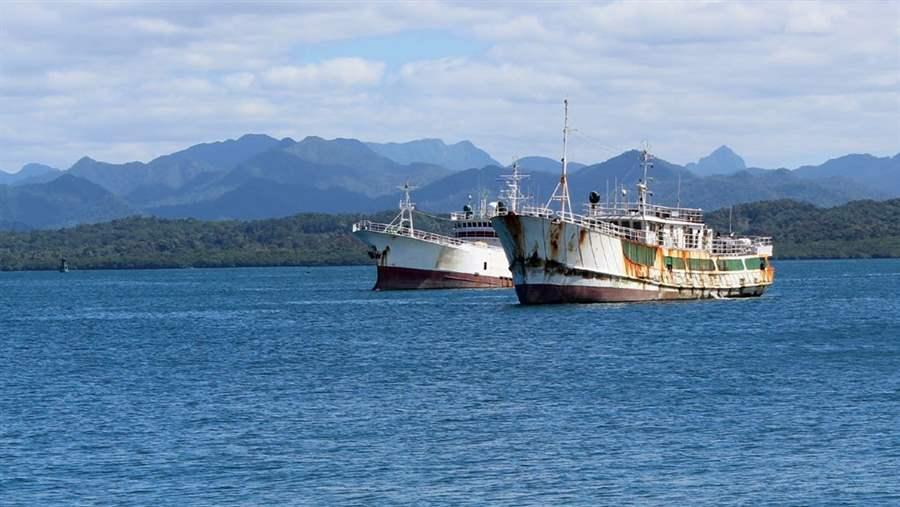 © The Pew Charitable Trusts
© The Pew Charitable TrustsPromising new fisheries management technologies have been developed that can make reporting and monitoring much faster and more effective
Editor's note: This document was updated Sept. 16, 2016, to reflect developments from the Western and Central Pacific Fisheries Commission’s Electronic and Monitoring Working Group meeting in August 2016.
Overview
Tuna longline fisheries in the western and central Pacific Ocean are not effectively managed today, in part because those responsible do not have the mechanisms in place to ensure sufficient and timely data submissions. In 2014, vessels using longlines caught fish with an end value of almost $4 billion in these waters.1 Fishing on that scale creates a strong motivation for resource users and managers to ensure sustainability by addressing gaps in accurately tracking fishing practices and catches.
Vessels currently report catch in longline fisheries predominantly through a paper-based system that is prone to error and processing delays and also to intentional manipulation. The Western and Central Pacific Fisheries Commission (WCPFC) requires just 5 percent of fishing effort by longline vessels to be independently observed, meaning that few catch reports are corroborated by an independent authority on board.
In recent years, promising new fisheries management technologies have been developed that can make reporting and monitoring much faster and more effective. Information on catches can now be relayed in near real-time in more standardized formats using electronic reporting (ER) systems. In addition, the WCPFC can expand observer coverage requirements with limited additional onboard personnel by using electronic monitoring (EM).
Nearly half of the world’s longline tuna fishing takes place in the western and central Pacific. These waters accounted for 46 percent of the catch in 2014.2 That fact, combined with the fact that bigeye tuna in this region are overfished and overfishing continues, makes it critically important for the WCPFC and its Members to leverage the power of technology to improve longline fisheries management by incorporating electronic reporting and monitoring into existing systems.
Recommendations for the ER and EM Intersessional Working Group
- Adopt draft standards for electronic reporting and electronic monitoring.
- Adopt draft strategies and time frames for design and implementation of electronic reporting and electronic monitoring systems, including training and operational sustainability.
Recommendations for the Technical and Compliance Committee, and then the Commission later this year
- Adopt electronic reporting and electronic monitoring standards that meet science and compliance requirements.
- Adopt strategies and time frames for design and implementation of electronic reporting and monitoring systems, including training and operational sustainability.
- Require 100 percent observer coverage on longline vessels, as is required on purse seine vessels, by complementing onboard human observer programs with electronic monitoring.
Raising the bar on longline fisheries management
Fisheries managers use two streams of data to collect scientific information and ensure compliance. The first is data provided by fishermen; the second is gathered by independent, government-trained observers. In theory, what a fisherman reports and what an observer reports from the same vessel and fishing trip should match.
For purse seine vessels, the WCPFC requires that every fishing trip carry a government observer on board, a rule that has been in place since 2010.3 It was adopted based on the principle that 100 percent coverage is essential for conducting science and monitoring for compliance with conservation and management measures.
For longline fishing, however, the Commission requires that only 5 percent of the effort have observer coverage. In 2012, WCPFC Members agreed to phase in the Regional Observer Program (ROP) for longline vessels, setting that modest level of coverage, but since then4 the 5 percent rule has been treated as a target rather than a minimum. As evidence, roughly a quarter of WCPFC Members still do not meet the requirement consistently.5
The WCPFC must raise observer coverage to 100 percent for longline fishing vessels to strengthen science and ensure compliance in such a valuable fishery.6 Electronic technologies can facilitate that.
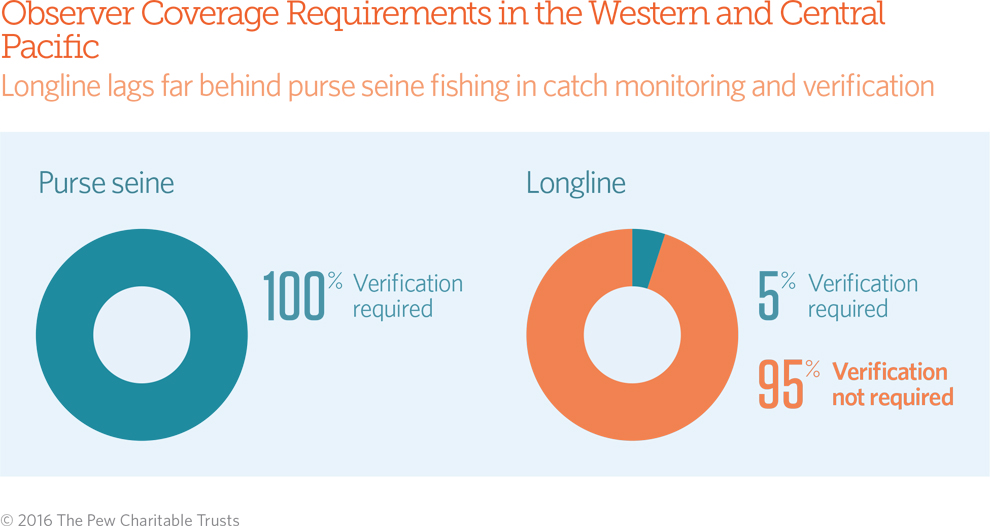
Electronic reporting: The basics
Improving the verification of longline catches requires accurate and timely reporting by the vessel master, or skipper. For decades, this has been done through paper logbooks, but this process is laborious and prone to manipulation and human error, and often takes considerable time to process.
Electronic reporting, which typically involves use of a tablet computer to enter catch and effort data and a Vessel Monitoring System (VMS) or GPS unit to identify fishing activity locations, enables the process to be standardized and streamlined and allows vessels to submit near real-time data. This information then can be delivered to scientists, fishery managers, and fishing vessel owners.
Electronic reporting, which typically involves use of a tablet computer to enter catch and effort data and a Vessel Monitoring System (VMS) or GPS unit to identify fishing activity locations, enables the process to be standardized and streamlined and allows vessels to submit near real-time data. This information then can be delivered to scientists, fishery managers, and fishing vessel owners.
Electronic monitoring: The basics
Electronic reporting provides for the timely submission of catch and effort data, but this information must be validated by a third party. Onboard fisheries observers traditionally fill this role. Some fleets point to the challenges of placing human observers on longline fishing vessels. Electronic monitoring—with cameras, sensors, and vessel monitoring systems—offers a valuable and effective substitute.
Monitoring longline vessels electronically will require minimum data standards, comparable to the minimum standards now in use by the ROP, to ensure that the information collected is accurate and consistent. For example, the WCPFC would set standards to ensure that electronic monitoring systems can measure all yellowfin tuna caught by longline vessels correctly and consistent with the process used by human observers.
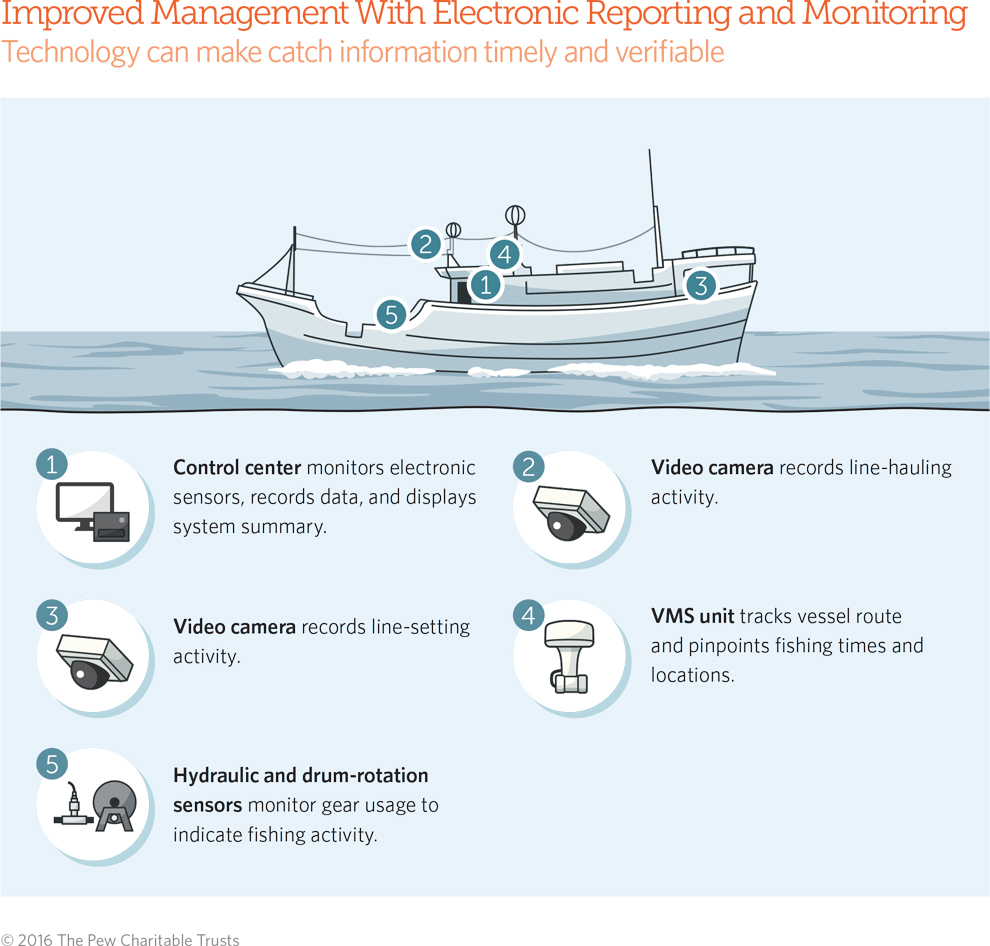
Benefits of Electronic Monitoring and Reporting
When standardized and implemented properly, electronic monitoring and reporting can increase:
- Efficiency: by reducing laborious and repetitive data entry.
- Timeliness: by reducing processing time for reports from weeks to minutes.
- Cost savings: particularly in cases where the use of human observers is expensive.
- Employment: by hiring people to review data and maintain systems.
- Transparency: by allowing vessel owners or fishing companies to monitor catches and activities occurring on their vessels, to ensure their legality.
- Compliance: by helping to document conformity with conservation and management measures and international obligations.
Most importantly, electronic reporting and monitoring can be used to supplement low human observer coverage and help managers ensure timely reporting and surveillance of resources and their exploitation so they can take action when needed.
Types of ER and EM
Electronic reporting and monitoring can be used on fishing vessels in different combinations to make best use of available resources. ER will help skippers and onboard human observers record catch and effort, while EM can help supplement limited levels of onboard observers. EM systems can capture the minimum data needed for science and can be used for compliance as well.7
Still, EM cannot collect biological data. It may not capture mitigation measures, such as steps to reduce bycatch, and it requires a basic level of maintenance from the crew, such as making sure camera lenses are clean and powered.8
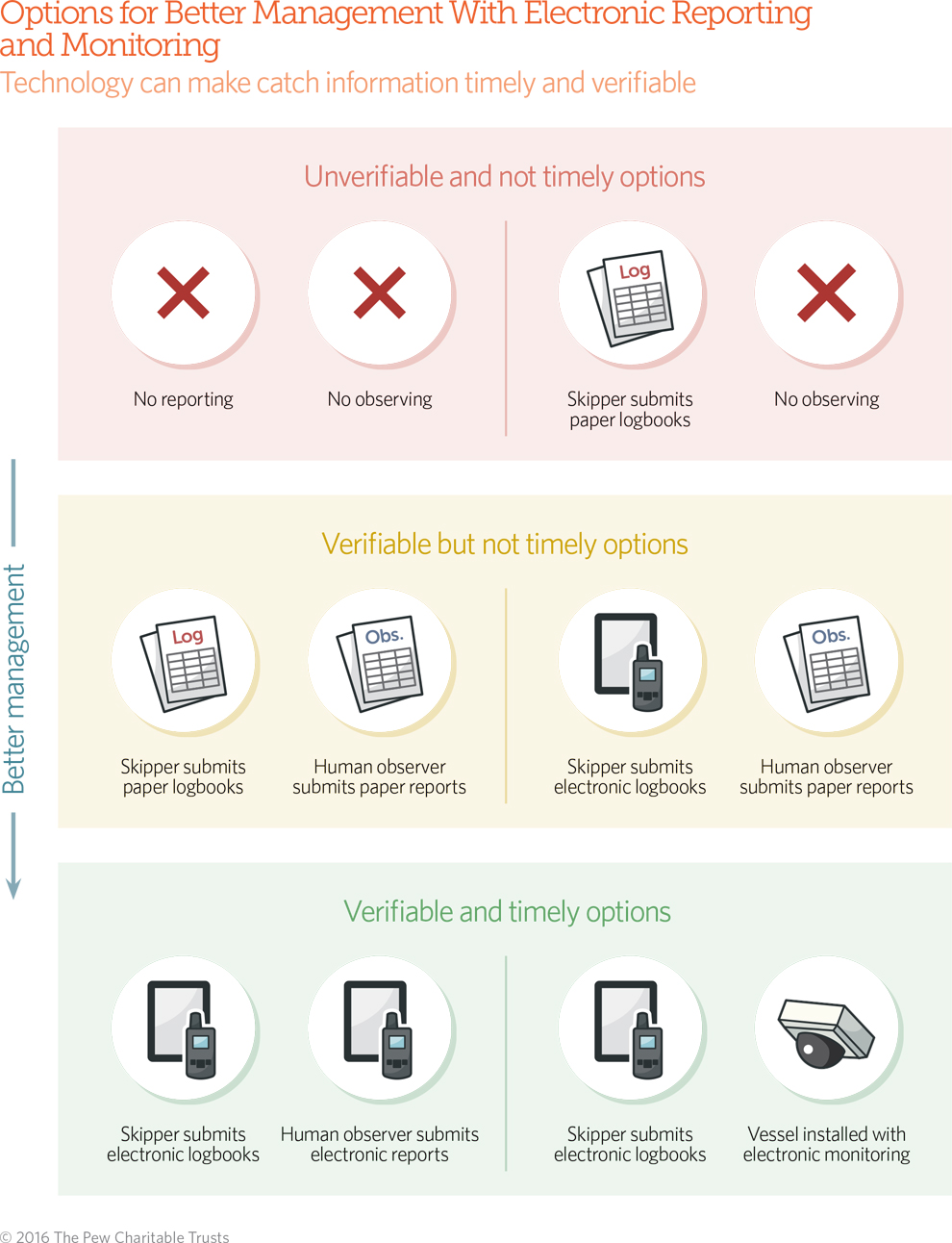
Electronic reporting standards
When the WCPFC considers electronic reporting standards, it should make sure that the scope applies to all relevant management measures.
The objectives in designing standards should be to:
- Make it easier to meet reporting requirements.
- Provide the secretariat with timely operational catch and effort data.
- Be mindful of related current and developing systems in use in WCPFC fisheries, including the ROP and catch documentation schemes.
Member responsibilities should include:
- Setting minimum data requirements.
- Setting ER formatting specifications: file type, name, etc.
- Approving technologies that meet minimum standards.
WCPFC responsibilities should include:
- Developing and maintaining technical and administrative systems for ER.
- Confirming ER data receipt.
- Auditing of systems and processes, and reporting results to ensure that standards are being met.
Electronic monitoring protocols and procedures
Although some national EM programs have been implemented, the WCPFC has yet to develop an international system that recognizes the trans-boundary nature of fishing and landings in Convention area waters.
These technologies are relatively affordable, but transmitting large amounts of data—video, sensor, and location information, for example—by satellite is not, at least for now. Unlike ER data (textual data), EM data at this point cannot be transmitted in bulk by satellite.9 That means the information must be retrieved physically or uploaded through cellular or Wi-Fi networks upon a vessel’s return to port, which adds to the costs.
Many vessels authorized to fish in the western and central Pacific work in multiple jurisdictions. As such, the data captured by these vessels would need to be reviewed by onshore government observers responsible for those areas; by a centralized, dedicated corps of onshore observers under data-sharing agreements; or outsourced.
Onshore observers would analyse EM data and produce reports similar to those of onboard observers. These would then follow identical data transmission paths to authorities such as the WCPFC and to science providers such as the secretariat of the Pacific Community.
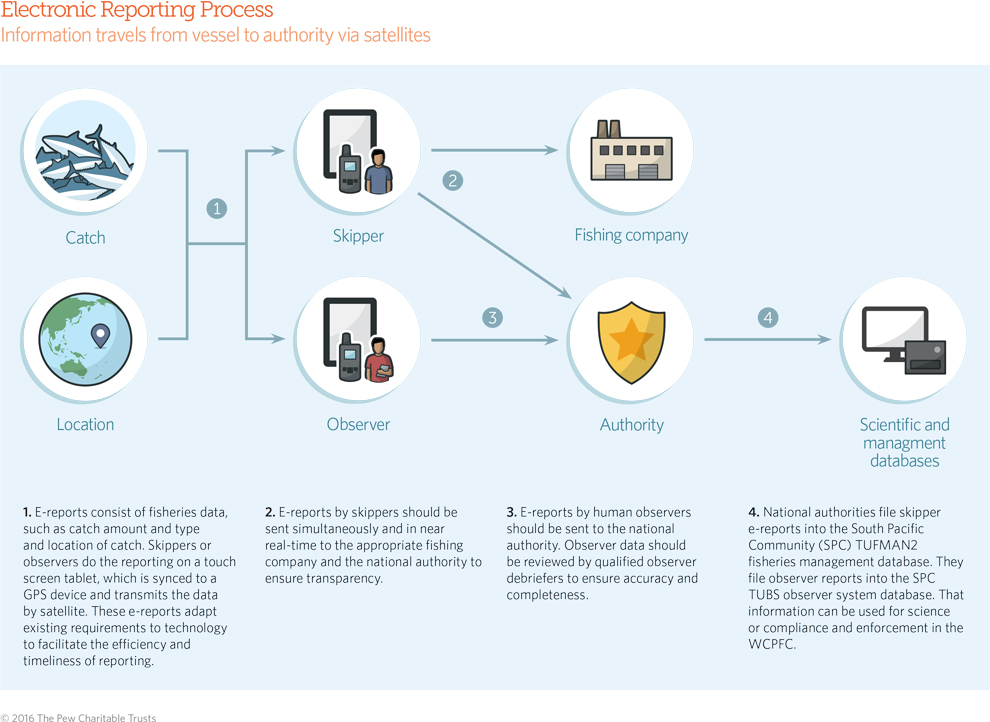
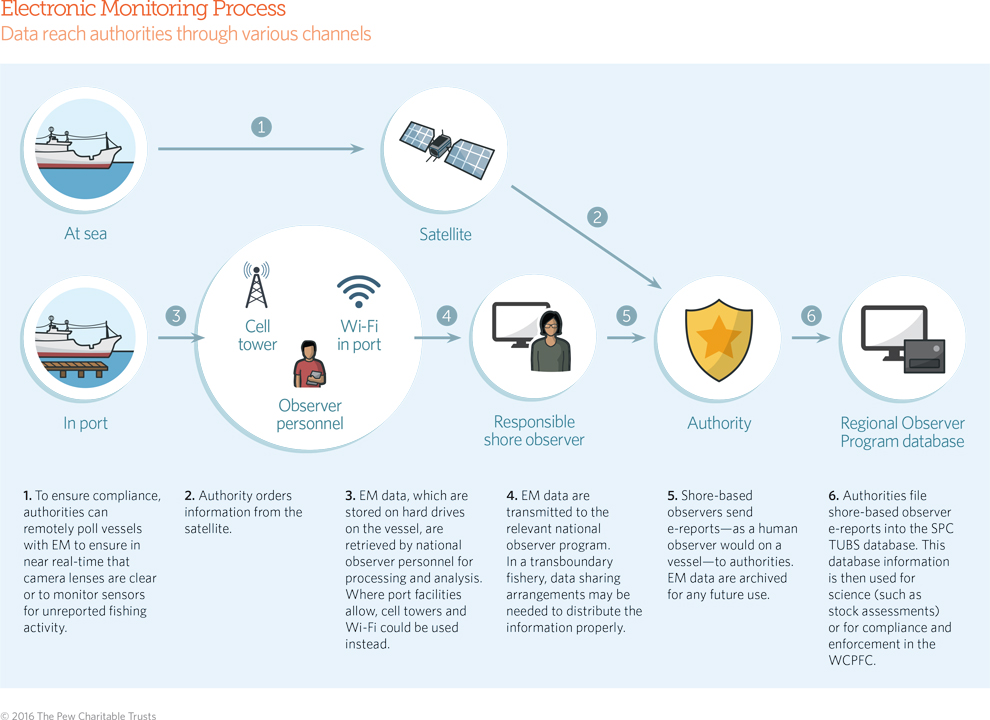
Electronic monitoring standards
When WCPFC considers EM standards, it should make sure that the scope applies to all relevant management measures.
The objectives for the new standards should be to:
- Verify catch reports for science and compliance with Commission conservation and management measures.
- Be mindful of related current and developing systems in use in WCPFC fisheries, including the ROP, vessel monitoring systems, and catch documentation schemes.
Vessel responsibilities should include:
- Maintaining EM system functionality.
- Returning to port every 30 days for EM data retrieval or making other arrangements to ensure data submission.
Member responsibilities should include:
- Setting minimum data requirements, similar to ROP standards, with the exception of biological information gathering.
- Approving EM system technologies.
- Setting protocols and procedures for EM data retrieval and processing.
WCPFC responsibilities should include:
- Ensuring the same administrative systems and processes for confirming receipt of data as with human observers.
Decision timeline
In 2013, the WCPFC established the ER/EM working group to consider how these technologies could support the objectives and implementation of the Convention.10 To that end, the working group is tasked with developing ER and EM standards, as well as a strategy for design and implementation. Table 1 highlights the status and key decision points for this policy development.
Conclusion
Technological advances, coupled with the increasing cost-effectiveness of electronic reporting and electronic monitoring, offer many possibilities for improving fisheries management. These include more near real-time catch reporting and improved fishing accountability, which benefit authorities, fishing boat owners, and associated industries. For these reasons and more, many countries have already embraced these technologies and more are likely to follow.
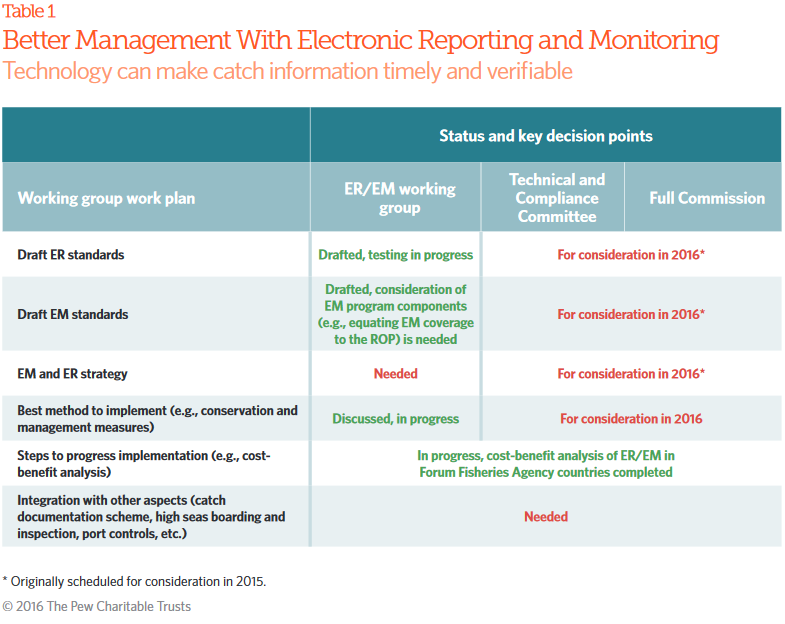
Endnotes
- Grantly Galland, Anthony Rogers, and Amanda Nickson, “Netting Billions: A Global Valuation of Tuna,” The Pew Charitable Trusts (2016), http://www.pewtrusts.org/~/media/assets/2016/05/netting_billions.pdf. Dock value and end value in 2014 for longlines in the westcentral Pacific Ocean were $1.3 billion and $3.9 billion, respectively.
- Ibid. The western and central Pacific accounted for 258,872 metric tons in 2014.
- Western and Central Pacific Fisheries Commission, “Agreed Minimum Standards of the Regional Observer Programme,” https://www.wcpfc.int/system/files/Agreed Minimum Standards of the Regional Observer Programme.pdf.
- Ibid.
- Western and Central Pacific Fisheries Commission, “Review of Guidelines for Long Line Observer Coverage,” WCPFC-2015- IWGROP4-08, Table 1 (2015), https://www.wcpfc.int/system/files/WCPFC-2015-IWGROP4-08%20Longline%20observer%20coverage%20matters.pdf. Roughly a quarter of the conservation and management measures continue to fall short of the 5 percent coverage of fishing effort observer requirement.
- Peter Williams and Peter Terawasi, Overview of Tuna Fisheries in the Western and Central Pacific Ocean, Including Economic Conditions—2014. Paper presented at the Western and Central Pacific Fisheries Commission Scientific Committee’s 11th Regular Session, Pohnpei, Federated States of Micronesia, 5–13 August 2015. Data presented in the report are five-year averages, from 2010–14, https://www.wcpfc.int/node/21762.
- Steve Dunn and Ian Knuckey, Potential for E-Reporting and E-Monitoring in the Western and Central Pacific Tuna Fisheries, Western and Central Pacific Fisheries Commission (2013), https://www.wcpfc.int/node/5586.
- Cameras can be remotely polled, at relatively little expense, to ensure that the recording functions properly.
- For monitoring, control, and surveillance purposes or for monitoring the health of the EM, the system could be remotely polled by satellite.
- Steve Dunn and Ian Knuckey, Potential for E-Reporting and E-Monitoring in the Western and Central Pacific Tuna Fisheries.






